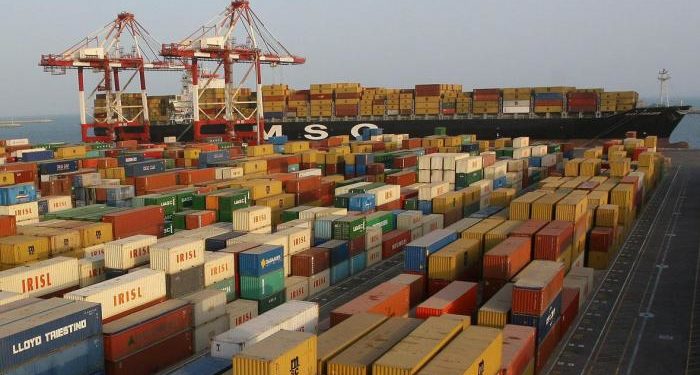
The economic decline of the Kingdom continues in light of the failure of the Saudi regime and its floundering, and the most recent evidence was shown by recent official data regarding the decline in the value of the Kingdom’s non-oil exports to the Gulf Cooperation Council countries by 12.9%, equivalent to 1.02 billion riyals.
The data of the General Authority for Statistics in the Kingdom revealed that the total value of non-oil commodity exports recorded about 6.85 billion riyals in the third quarter of 2019, compared to about 7.86 billion riyals in the same period of 2018.
The value of imported goods of national origin from the Gulf Cooperation Council countries reached about 13.5 billion riyals in the third quarter of 2019, compared to 14.53 billion riyals in the third quarter of last year, a decrease of about 1.02 billion riyals, equivalent to 7%.
According to the statistics of the statistics, the Kingdom achieved a trade deficit with the Gulf countries, excluding oil, about 2.4 billion riyals during the third quarter of 2019, compared to 2.75 billion riyals in the same quarter of 2018.
In the trade exchange with the Kingdom, the UAE is advancing with exports of 3.99 billion riyals, representing 58.4% of the total exports to the Gulf countries, and 10.19 billion riyals and imports representing 75.5% of the total imports from the countries of the Cooperation Council in the third quarter of 2019.
The authority’s data stated that the Kingdom’s total trade surplus amounted to 97.85 billion riyals in the third quarter of 2019, compared to about 160.41 billion riyals in the corresponding quarter of 2018.
The Kingdom’s surplus in the third quarter of this year was the result of the difference between 236.08 billion riyals in total exports and 138.23 billion riyals in the total value of imports.
And official data previously showed that the Kingdom’s exports of crude oil fell to 6.67 million barrels per day from 6.88 million barrels per day in August.
The Kingdom’s total exports of crude fell 0.660 million barrels per day in September to 9.126 million barrels per day.
Crude inventories fell 20.27 million barrels to 152.48 million barrels in September, while crude used in local refineries increased 0.010 million barrels per day to 2.584 million barrels per day in September, according to the figures.
Official statistics revealed that the Kingdom’s foreign trade surplus (oil and non-oil) continued to decline by 20.8% year on year in the first nine months of 2019.
According to data issued by the General Authority for Statistics in the Kingdom (government), the trade balance surplus amounted to $90.5 billion. The surplus of the Kingdom’s trade balance reached $114.2 billion during the corresponding period of 2018.
The value of merchandise exports (oil and non-oil) decreased by 9.3% to 197.1 billion dollars, while imports increased 3.5% to 106.6 billion dollars.
The value of “oil” exports to the Kingdom decreased by 10.3% to $152.8 billion.
The Kingdom’s trade surplus (oil and non-oil) increased during 2018, by 87.5%, to $159.3 billion, compared to $ 85 billion in 2017.
The Kingdom faces many challenges due to the failure of the Saudi regime, the corruption of its officials and the failure of its policies at all levels, but it has become the latest and perhaps most notable of the worsening economic crisis in recent years.
The most prominent evidence of the challenges of the economic crisis of the Kingdom is the aggravating deficit of its economy on the one hand and the escaping of foreign investment on the other.
This is supported by the fact that foreign capital will not invest in long-term projects in a country that suffers not only from the absence of political and economic freedoms, but also social as a result of the policies of the Saudi regime.
For years, the Kingdom’s budget has been issued with a growing deficit after decades of huge oil surpluses. The budget for the coming year 2020 was issued with expected expenditures amounting to 272 billion dollars, including an expected deficit of 50 billion compared to 35 billion in the budget for the current year 2019. With the new deficit, the total deficit in the budgets of the Kingdom since 2014 is expected to reach about 435 billion dollars.
With the price of a barrel of oil remaining at around $60 and a weak rate of economic growth and the costs of armaments, security and war in Yemen, the Kingdom must rely on more loans, higher taxes and higher government support for goods and services; in addition to privatizing state sector companies to fill the growing deficit in the budget and finance construction projects Ambitious infrastructure.
In this context, the first privatization process took place, which involved selling 1.5 percent of the Aramco oil company in the form of shares with revenues exceeding $25 billion, but it was limited to domestic investments only, without any foreign participation.
Moreover, these returns, despite their importance, constitute only a fraction of the funds needed for the sovereign wealth fund, through which the ambitious plan projects “Vision 2030” are also funded.
This vision, worth $2000 billion, was launched by Crown Prince Mohammed bin Salman in 2016 with the pretext of modernizing the kingdom and moving its economy from addiction to depend on oil to the era of dependence on multiple sources of income such as tourism and manufacturing.
So far, the Saudi regime has managed to bridge a large portion of the Kingdom’s budget deficit by imposing multiple means, most notably imposing new taxes and fees in addition to borrowing and confiscating the money of princes and wealthy people accused of corruption.